 |
  Home | Contact | Site Map |

| Top Destinations |
|
You are here Home » Top Destinations » Kaziranga National Park Assam
Honeymoon in Kaziranga National Park, Assam, India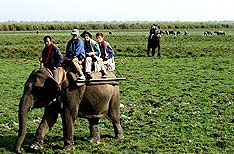 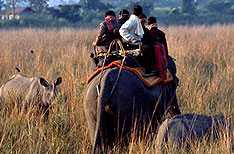 About Kaziranga National Park In the heart of Assam, this park is one of the last areas in eastern India undisturbed by a human presence. It is inhabited by the world's largest population of one-horned rhinoceroses, as well as many mammals, including tigers, elephants, panthers and bears, and thousands of birds. The National Park is famous for the protection and preservation of one horned Rhinoceros (Rhinoceros unicornis). The main object of this National Park is to conserve and protect the Rhinoceros and its habitat. The National park receives heavy rain from May onwards and part of the National Park will be inundated by floodwaters every year. The average rainfall is 2500mm every year. The park was enlisted in the list of world heritage convention in its 9th session held in Paris during December, 1985. It was constituted into a reserved forest in the year, 1908 and then declared as a game sanctuary in 1916. It was upgraded into a National Park in 1974. The area is 473.71 sq.kms, which is spread over the three adjoining districts of Golaghat, Nagaon and Sonitpur. The area is almost flat all over having a few tributaries of Bramhaputhra river flowing through it. There are some water bodies of varying sizes distributed here and there. It bears tall grass growth all over the area. The National High way No.37 runs along the southern boundary of the park, which makes the communication easier. Minimukhi is a good viewing area. There is a good network of fair weather roads. All facilities are available to visitors including hired elephants for taking the visitors. Tourists coming from overseas are required to procure restricted area entry permit from the authorities concerned either in Delhi or Calcutta. The permit is issued liberally to groups of 6 or more intending visitors. HISTORYIt all began on 16th July 1902, when the Honorary Secretary, Zoological Garden, Calcutta wrote a letter to Mr. J.C.Arbuthnott, the Officiating Commissioner of the Assam Valley Districts, requesting an adolescent rhino for its conservation campaign. Mr. Arbuthnott invited the attention to the dwindling number of the rhino to the Chief Commissioner of Assam citing unchecked poaching as the reason, ?yearly incursions of large shooting parties?. He further comments in his letter ?there is, I think, still time to preserve the very few that are left?. The Chief Commissioner Mr. Fuller, responded favorably who wrote back ?it would be most regrettable if the Rhinoceros became extinct in Assam?. He then ?gladly considered the possibility of establishing an asylum for the rhinoceros in Assam by taking up as reserve forest a sufficient area of suitable land?. Soon after, a series of communications and surveys followed, which culminated with the Chief Commissioner informing the Conservator of Forests, Assam on 22nd December, 1904 about his decision that the Kaziranga block may be created a Forest Reserve. On 1st June 1905, The Chief Commissioner issued a notification declaring an area of 57,273.6 acres as the Kaziranga Proposed Reserve Forest. Kaziranga was established as a Reserve Forest in 1908. It became a Game Sanctuary in 1916, but was still vulnerable to poachers and hunters alike. In response to outcries that the rhino was headed for extinction, hunting was banned and Kaziranga was declared a Forest Reserve (230 sq km) and then a Wildlife Sanctuary in 1926. It opened to visitors in 1938 thanks to the initiative of A J W Milroy, Chief Conservator, who put an end to much of the poaching. In 1950 Kaziranga was declared as a Wild Life Sanctuary. In 1954, the rhino was given legal protection through the Assam (Rhinoceros) Bill that laid down heavy penalties for killing it. Kaziranga was declared as the first National Park of Assam in 1974 under the Assam National Parks Act,1968 and the original core area of 428 sq km was declared a World Heritage Site in December 1985. KAZI AND RANGAThere is an interesting story about how the name Kaziranga came about: a young man Kazi from Karbi Anglong fell in love with Ranga, a village belle from the Assam plains. The parents would not approve of their courtship, so they could only fleetingly meet in the forest. The forest became their favorite abode. One day both of them suddenly disappeared never to return, much to the anguish of their respective parents. The forest was thereafter named Kaziranga in the memory of the young lovers. FOREST TYPEEvergreen and Semi evergreen forest, moist deciduous forest and open swamp and grasslands. WILDLIFEImportant animals are Rhinos, Elephants, Tigers, Leopards, Leopard cat, Buffalo, Gaur, Sloth bear, Black bear, Malayan Sun bear, Hoolock, Rhesus macaque, Common Langur, Capped Langur, Swamp deer, Sambar, Barking Deer, Hog deer, Common otter, Clawless otter, Wild boar, Python etc. Important birds are ?Spot billed Pelican, Darter, White necked Adjutant stork, Black necked Adjutant stork, Lesser Adjutant stork, Cormorant, Little Egret, Heron, Tuffed Duck, Brahmini Duck, Fish eagle, Bengal Florican, Pied Hornbill, Green Pigeon, Jungle fowl, Grey partridge, Pheasant etc. No significant research works seem to have been done in the National Park but well managed. FLORAKaziranga is the largest floodplain grassland of its kind, still surviving in India. About 70 % of the park area is covered with grasses. The tall grasses also called 'elephant grass' grow up to a height of five metres during the rains. In the Western Range these grasslands predominate with shorter grasses growing around the waterbodies that are locally known as 'beels'. The grasslands are dominated by species such as Saccharum elephantinus, Imperata cylindrica, Poinia ciliata, Erianthus ravannae, Saccharum arundinaceum, Arundo donax and Phragmites karka among others. Interspersed among the grasslands are cane brakes and woodlands that are dominated by deciduous species such as Bombax ceiba, Albizzia odorotissima, Carreya arborea, Lagerstromia parviflora, Dillenia pentagyna and Zizyphus jujuba among others. The tree forests occupy comparatively higher ground along the central portion of the Park and on the Eastern portion. The tropical wet evergreen forests that are found on the south of the National Highway extend into the Karbi Anglong hills and are dominated by species such as Artocarpus chaplasha, Bridelia retusa, Duabanga grandiflora, Aesculus asamica, Schima wallichi, Gmelina arborea, Erythrina indica among others. These forests are dense, impenetrable and provide refuge to animals during the flood season. In the summer months a variety of orchids can be seen on display. They are epiphytes and take their sustenance from nutrients that gather high up on tree branches. Also during the summer, the Silk Cotton tree (Bombax ceiba) turn 'red' with the synchronized blooming of the flowers and later disperse their seeds in white balls of fluff that float through the air and add considerably to the charm of Kaziranga. FAUNAThough Kaziranga is famous all over the world as the "Rhino Land" or the home of the Great Indian One Horned Rhinoceros, many other rare and endangered animals also inhabit the National Park, the survival of which is equally dependent on the proper conservation and management of the Park. General Information of Kaziranga National Park LOCATIONKaziranga National park can be approached by road from the nearest town of Bokakhat, which is about 23 km away. The nearest railway station and airport is Jorhat at a distance of 84 km. Jorhat is 303 km from the Assamese state capital of Guwahati. State transport buses ply between the two cities. How to Reach By AirThe nearest airport is situated at Guwahati, which is 217-km away from the park. The other airport is located at Jorhat, 97-km from Kaziranga. By RailThe nearest railhead is Furkating, situated 75-km away from Kaziranga National Park. By RoadThe main gate for Kaziranga Wildlife Sanctuary, at Kohora on the NH-37, consists of a handful of cafes and a small local market. ASTC and private buses stop here on their way to and from Guwahati, Tezpur and Upper Assam. Some private buses also retain a seat quota for Kaziranga passengers. CLIMATEWeather in Kaziranga is pleasant throughout the year. There are no extremities in terms of temperature variation. The winters (November-January) are cool and summers warm (temperature does not exceed 38?C). Monsoon (June-July) season is dominant and lasts for a long time in this area. Mild showers may be experienced throughout the year. Mid-April to mid-October is the closed season and you are advised not to venture out during this period. For summers, light cottons would be suitable, but in winters, it is advisable to carry heavy woolen clothing. BEST TIME TO VISITKaziranga's visiting season is from mid-November to early April months. During the monsoons, the Brahmaputra River bursts its banks, flooding the low-lying grasslands and causing animals to migrate from one area to another within the Kaziranga National Park. Tourist Attractions IN Kaziranga National Park
The areas adjoining the park, though they sound like tough terrains, are easily accessible on the backs of elephants. Mihimukh is the starting point for the park and elephants can be hired from here to enter the sanctuary. An elephant-ride during early hours of dawn awards an excellent opportunity for seeing wildlife at a close range. The elephants are managed by authorized mahouts (trainers), who guide visitors through the park. The park contains about 15 species of India's threatened (Schedule I) mammal species. The best-known inhabitant of course is the Rhinoceros unicornis (rhino) and they make it their largest home anywhere in the world. The number of this once-threatened mammal has been regularly in the increasing order. From only a few dozen in 1908 to more than 1000 now, the route has been quite long. Rhinoceros(Rhino)
Avifauna (Wildlife)
Other Wildlife
Observation Towers Forest department has constructed some observation towers for good watch of wildlife. These towers are located at Sohola, Mihimukh, Kathpara, Foliamari and Harmoti. |
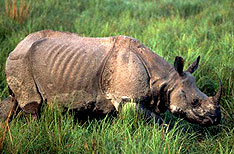 Kaziranga National Park is one of the most picturesque wildlife parks in India. Apart from being the home of the one-horned rhino, it is also the natural habitat of wild buffaloes, wild boars, elephants, Barasinghas (swamp and hog deer), leopards, tigers, hoolock gibbons, capped langur, rock python, monitor lizards, various species of eagles, partridge, bar-headed geese, whistling teals, florican storks, herons, pelicans and water fowls. Large areas of the park comprise of marshland interspersed with large pools fringed with reeds, patches of elephant grass, scattered trees, and thickets.
Kaziranga National Park is one of the most picturesque wildlife parks in India. Apart from being the home of the one-horned rhino, it is also the natural habitat of wild buffaloes, wild boars, elephants, Barasinghas (swamp and hog deer), leopards, tigers, hoolock gibbons, capped langur, rock python, monitor lizards, various species of eagles, partridge, bar-headed geese, whistling teals, florican storks, herons, pelicans and water fowls. Large areas of the park comprise of marshland interspersed with large pools fringed with reeds, patches of elephant grass, scattered trees, and thickets.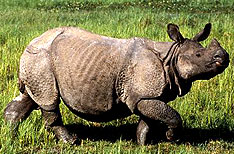 Contrary to what one may have heard, rhinos browse past visitors nonchalantly. The rhino is a peace-loving animal and, instead of batting an eyelid about peaceful tourists who have invaded its territory, it keeps itself busy grazing in the wild. Moreover, the conditions at Kaziranga are ideal for the rhino to survive. In addition to elephant rides, several watch towers have been set up for elevated viewing of the wildlife park. Pleasant boat rides at the nearby Rhinoland Park can also be availed by tourists.
Contrary to what one may have heard, rhinos browse past visitors nonchalantly. The rhino is a peace-loving animal and, instead of batting an eyelid about peaceful tourists who have invaded its territory, it keeps itself busy grazing in the wild. Moreover, the conditions at Kaziranga are ideal for the rhino to survive. In addition to elephant rides, several watch towers have been set up for elevated viewing of the wildlife park. Pleasant boat rides at the nearby Rhinoland Park can also be availed by tourists.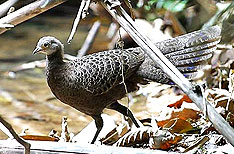 Kaziranga is also an ornithologist's delight and you can find a great number of avifaunal species here. The numerous water bodies of Kaziranga are rich reservoirs of food (including fish) and thousands of migratory birds, representing over 100 species, visit the park seasonally from as far as Siberia. Major migratory birds are the grey pelican, black-necked stork, lesser adjutant stork, Pallas's fish eagle, grey-headed fish eagle, about 25-30 Bengal floricans, swamp partridge, grey peacock-pheasant, great pied hornbill, green imperial pigeon, and silver-breasted broadbill. Sunset is a pleasant sight as well, with the birds returning to their nests.
Kaziranga is also an ornithologist's delight and you can find a great number of avifaunal species here. The numerous water bodies of Kaziranga are rich reservoirs of food (including fish) and thousands of migratory birds, representing over 100 species, visit the park seasonally from as far as Siberia. Major migratory birds are the grey pelican, black-necked stork, lesser adjutant stork, Pallas's fish eagle, grey-headed fish eagle, about 25-30 Bengal floricans, swamp partridge, grey peacock-pheasant, great pied hornbill, green imperial pigeon, and silver-breasted broadbill. Sunset is a pleasant sight as well, with the birds returning to their nests.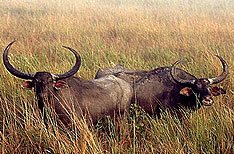 Apart from being the home of the one-horned rhino, Kaziranga is also the natural habitat of wild buffaloes, wild boars, elephants, barasingha (swamp deer), leopards, tigers, hoolock gibbons, capped langur, rock python, and monitor lizards. Although tigers inhabit this park, it is quite difficult to sight one.
Apart from being the home of the one-horned rhino, Kaziranga is also the natural habitat of wild buffaloes, wild boars, elephants, barasingha (swamp deer), leopards, tigers, hoolock gibbons, capped langur, rock python, and monitor lizards. Although tigers inhabit this park, it is quite difficult to sight one.